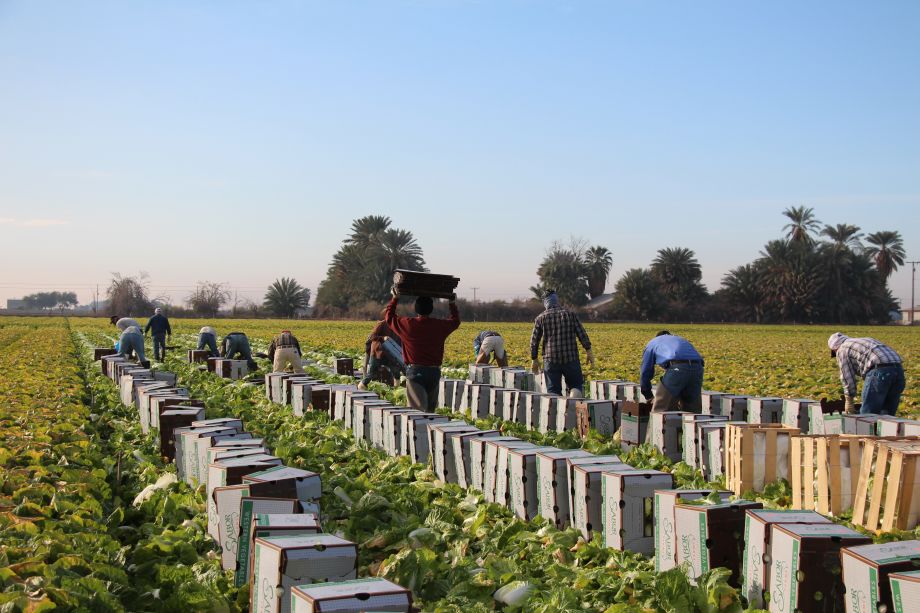Vegetable Growers Rally to Conquer COVID-19-Induced Challenges

The coronavirus crisis brought even more attention to the ongoing issue of farm labor and its essential role in delivering fresh produce to grocery stores, restaurants, schools, and beyond.
The vegetable industry in 2020 is living through extraordinary times. The State of the Vegetable Industry survey we conducted this year gave us invaluable insight into what you are experiencing when it comes to production issues, labor, and specialized areas like protected agriculture and technology.
Since the coronavirus pandemic upended business as usual, we assembled a group of industry experts to discuss what they’re seeing and where they think we’re heading.
Here are some of highlights from that fascinating conversation:
The Worst Is Behind Us
When state governments across the U.S. issued stay-at-home orders, it caused disruptions the industry hasn’t experienced since the last world war.
One example is the H-2A program. It underwent emergency regulation changes, causing confusion at the border. That in turn led to temporary delays in late March.
“I think we’ve gotten past that right now,” says Kam Quarles, CEO of the National Potato Council.
The sharpest upheaval happened in food service. Demand collapsed once restaurants and schools closed their doors, leaving growers with fields ready to harvest and nowhere to go.
“If you want to see a farmer cry, it’s plowing under a beautiful romaine crop,” says Steve Koike, Director at TriCal Diagnostics in California’s Salinas Valley.
An unexpected disruption happened at the grocery store level. Although that sector saw an overall surge in sales, many retailers cut back on fresh vegetables temporarily. And the resulting lack of produce in grocery stores shocked the country.
“When I was going to local grocery stores here for a couple months, produce was limited and what was there was pretty crappy, to be honest. And I’m living in the middle of the Salinas Valley,” Koike says.
How to Manage Production Levels?
Obviously, we’re not back to a normal year yet.
“[Food service] growers know they won’t have the same market as before COVID,” Koike says.
The big question is how much they should cut back, he says. Growers are making their best guesses, with differing responses across the country.
In the Northeast, many growers are banking on an almost normal fall, Richard VanVranken, Professor and County Extension Department Head of Rutgers Cooperative Extension says.
In California, however, growers cutting back their production has had a visible impact.
While planting-season and mid-season labor seems well in hand, growers don’t know what harvest season will bring.
“I know folks are kind of bracing themselves for what that’s going to look like,” Quarles says.
Existing Strong Systems Not Designed for Pandemics
Our channels work against us during emergencies, several of the experts said.
University of Arizona Yuma Agricultural Extension Center’s John Palumbo says growers he works with are highly specialized. So they cannot easily switch to new customers or crops.
“We are locked into what we do,” Koike agrees. “It’s not like a lettuce grower is going to start growing hemp.”
That’s a good thing in normal times, but it creates a lack of nimbleness that can hurt the industry during crises.
That gives smaller and more diverse growers an advantage, VanVranken says.
“Farmers with their own markets opened early and made adjustments so they could do social distance,” he says.
One major shift Michael Cahn, Irrigation and Water Resources Advisor with University of California, Cooperative Extension, Monterey, CA, is seeing: growers aren’t planting unless they have orders.
“The plantings tend to be smaller than they were before,” he says. “So if you had a six-acre butter lettuce field, it’s now three acres.”
Cahn says growers are also combining a number of different plantings in the same field, and for more than one customer.
“That’s a lot more management in a smaller area,” he says.
Palumbo points out many ancillary businesses, like crop protection retailers, may not be in the spotlight, but their fortunes rise and fall with growers.
“They’re facing a very similar battle,” he says.
Higher Labor Costs Boosting Technology
Growers across the country rallied to keep their workers safe. That includes adding more buses to keep fieldworkers social distanced during transport to the fields, harvesting every other row on the one pass, then shifting to over a row at the end of the field.
VanVranken says New Jersey has issued guidance on how to create safe barriers between bunks in worker housing.
All these necessary protective measures are expensive. And that may give mechanization a boost, Palumbo says.
“You’ve seen a slow transition to mechanical thinning,” he says. “You may see an increase after this.”
Government Key to Recovery
The produce world is famously independent. A prevailing viewpoint is the less government interferes with the industry, the better.
But 2020 is different.
“When the government says you can’t have any customers, guess who becomes your customer? The government,” Quarles says.
It’s only a short-term solution, he says.
What are produce lobbyists asking for? For the government to purchase backlogged produce and for direct payments, Quarles says. He not only heads up the National Potato Council; he also serves on a unified board made up of several fruit and vegetable crop groups.
One issue they’re trying to address is how the government determines which growers benefit and by how much. It needs data upon which to make policy decisions. If it uses the wrong data, it can leave some growers unprotected.
When the government issued the first rescue package, it used data from the grocery channel.
“We had no idea they were going to use a pricing framework as a trigger for if you would be included in the program or not. [Grocery pricing applies to] only 40% of our business,” Quarles says. “60% of our business cratered and there was no visibility.”
A Strong Future Lies Ahead
All the experts expressed faith that 2020 will be just one rough patch in a strong industry.
“These growers are survivors and very creative. They’ll adjust to the new normal,” Koike says.
If we can find a positive that comes out of the pandemic, it may be how this highlighted the importance of agriculture to Americans.
“The thought, early on in the crisis, that you could go to the grocery store and not see food there? I think that was really shocking to folks,” Quarles says.
That gives the industry a strong backing to spur Congress to act on its behalf and help it get past 2020 and into a strong future.
Too Many Potatoes in the System
The potato industry has been especially hard hit, says Quarles. Since 60% of the potato industry was supplying food service, when the bottom fell out, it created a tremendous backlog.
“We have over a billion pounds of potato and potato products that are clogged up in the pipeline,” Quarles says.
To put that in perspective, Quarles and his team did the math. A billion pounds will fill up the U.S. Capital building 14 times.
The impact of so much crop in the system when potato growers were at the beginning of a new season is huge.
For one, processors who contract with growers simply don’t need as much from them in 2020. In some cases, they don’t need any crop.
“You’re potentially looking at impacts on growers that can echo out 18 months,” Quarles says.
Export markets are also vulnerable to the backlog. It can potentially flood the market, creating havoc with prices both abroad and domestically. For that reason, countries across the world are adding protective tariffs, including the E.U. and Australia.
“People are pulling up the drawbridge,” Quarles says.
Thank you to our sponsors!












